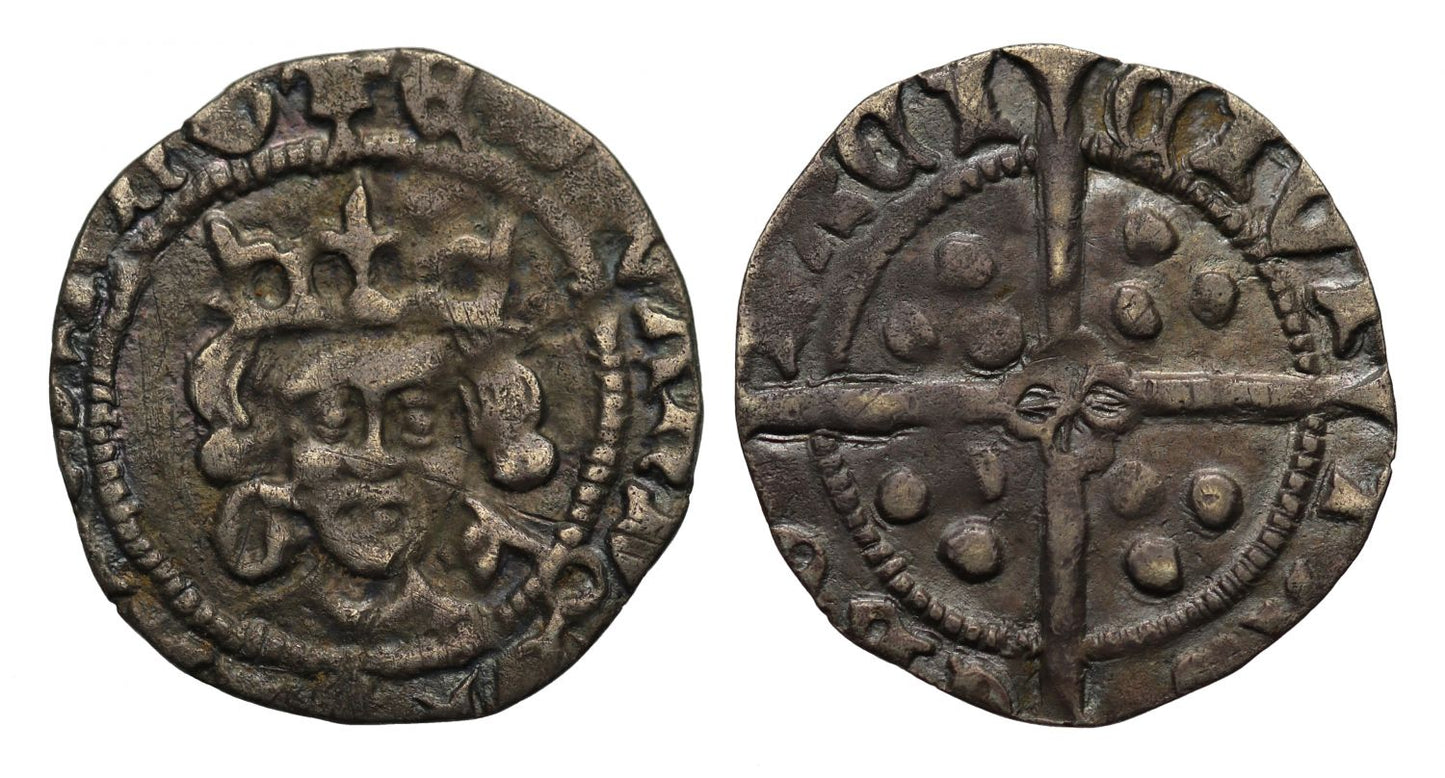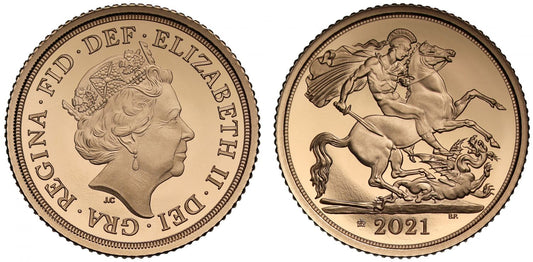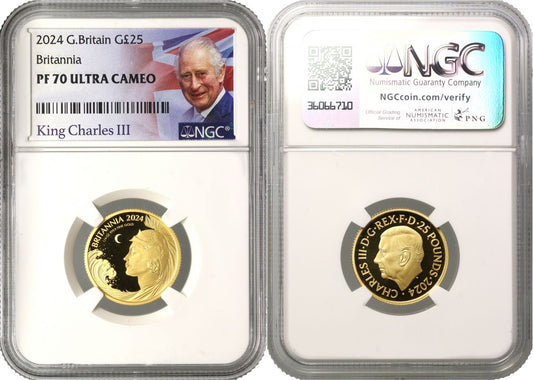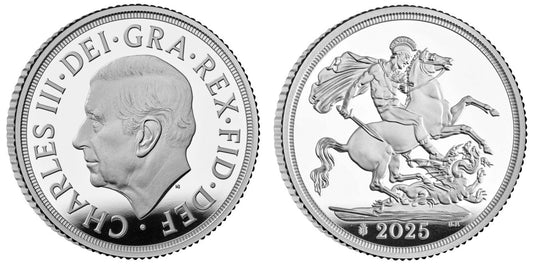FAQs
What makes a coin valuable?
I have coins to sell, what’s the next step?
How will my purchases be shipped?
What happens if I’m not entirely happy with my purchase?
Edward IV, first reign, Penny, York Mint, issued under Archbishop George Neville
Edward IV, first reign (1461-70), silver long cross Penny, light coinage (1464-70), York Mint, London cut dies, ecclesiastical issue under Archbishop George Neville, facing crowned bust in beaded circle, G to left of neck, key to right which intrudes legend, initial mark small lis, legend surrounding, beaded outer border, +EDWARD. DI GRA REX. AnG, rev. long cross pattée, quatrefoil at centre, tri-pellets in each inner angle, beaded circles and legend around, CIVI TAS EBO RACI, weight 0.51g (N.1599; S.2063). Toned, with a lovely clear portrait and symbols, one light scratch across face, otherwise good very fine.
The Latin abbreviated legend translates as "Edward, by the grace of God, King of England" and on the reverse "City of York."
Born on the 28th April 1442 in Rouen, the son of Richard Plantagenet the third Duke of York, Edward inherited the Yorkist claim on the death of his Father at the Battle of Wakefield in December 1460. After then defeating Lancastrian forces at the Battle of Towton on 29th March 1461 in a snowstorm, he deposed King Henry VI imprisoning him in the Tower of London. Edward went on to marry Elizabeth Woodville on 1st May 1464 with whom he had seven daughters and three sons, seven of which survived him, though the two surviving sons later became known as the tragic "Princes in the Tower".
Firstly, though the marriage of Edward to Elizabeth enraged the Earl of Warwick, as Elizabeth was a widow of Lancastrian John Grey of Groby killed at Towton and had had two sons with him. Later Edward dismissed his Lord Chancellor in 1467 George Neville the Archbishop of York, who was Warwick's brother causing Warwick to form an alliance against Edward with the latter's younger brother the Duke of Clarence, who owned neighbouring estates to Warwick. King Edward then blocked a marriage proposal between Clarence and Warwick's eldest daughter Isabel, but the marriage went ahead and took place in Calais, France presided over by George Neville. The three men then issued a "remonstrance" of alleged abuses by the Woodvilles and other advisors of Edward, returned to London and raised an army which went on to defeat the Royal army at Edgecote Moor on 24th July 1469 with Edward then being held at Middleham Castle. On the 12th August Edward's Father in law Richard Woodville and his youngest son John were executed at Kenilworth Castle, but subsequent support for the actions of Warwick and Neville were low and Edward was released in September to resume rule. Edward went on to reinstate Henry Percy as Earl of Northumberland, who had previously fought for Lancaster giving back his estates that had been presented to John Neville, Warwick's brother with Neville in turn being given the title Marquess of Montague as compensation. By March of 1470 Warwick and Clarence escalated a more private feud into a full scale revolt, but were defeated fleeing to France by May of that year. Louis XI encouraged Warwick to negotiate an alliance with Queen Margaret, and with French support they landed in England on 9th September 1470 to restore King Henry. An army of 30,000 was formed as Yorkist support in England was low. Edward narrowly escaped capture to Bruges and Henry was restored. Edward received little support from his brother in law Charles the Bold, but by March 1471 backed by Flemish merchants he landed near Hull close to his Yorkshire estates, and persuading the City of York to open its gates to him. He marched south gaining more support along the way entering London unchallenged and taking Henry prisoner. Warwick was defeated and killed at the Battle of Barnet on 14th April 1471, and Edward Westminster the son of Henry, was killed at the Battle of Tewkesbury on 4th May 1471, with the imprisoned Henry dying shortly after. Edward's second period of rule began, and he had only to quell one significant rebellion in February 1474 by John de Vere the 13th Earl of Oxford, who survived to be in command of the Lancastrian army at Bosworth field nine years later. The Duke of Clarence was alleged to have been involved in the rebellion leading to his execution at the Tower on 18th February 1478. In 1475 Edward allied with Burgundy to declare war on France and Louis opened negotiations with Edward, landing at Calais and signing the Treaty of Picquigny giving a payment of 75,000 crowns to Edward and a pension of 50,000 more a year which helped recoup costs of his army. In 1482 Edward backed an attempt by Alexander Stewart to usurp the Scottish throne from James III which led to withdrawal, only capturing Berwick Castle. Edward fell fatally ill at Easter 1483 and survived long enough to add codicils to his will placing his brother Richard as Protector of his son Edward. Edward IV died on the 9th April 1483.
George Neville (c.1432-8th June 1476) was the youngest son of Richard the 5th Earl of Salisbury and the younger brother of Richard the 16th Earl of Warwick. Educated through Baliol College Oxford and destined for a clerical profession he became Bishop of Exeter in 1458 consecrated on the 3rd December. He became keeper of the Great Seal after the Battle of Northampton at which he was present with his elder brother in July 1460 and was involved in later proclaiming Edward IV King. He also served as Chancellor of the University of Oxford for many years.
George Neville helped with negotiations with Scotland in 1464 and subsequently became Archbishop of York on the 15th March 1465 and was enthroned at Cawood Castle in September of that year. The enthronement was an extravagant large gathering with amongst the guest list, 28 Peers, 59 Knights, 10 Abbots and 7 Bishops in attendance with thousands of meals served.
In subsequent years the Neville Family fell out of favour with Edward IV and he took back the Great Seal in June 1467 for George Neville's obstruction of his Royal plans. In 1469 after a Yorkshire rising the King fell into the hands of Archbishop Neville and was briefly imprisoned before being permitted to escape. Neville's brother Warwick was defeated at Stamford in 1470 and the Archbishop took an oath of allegiance to Edward who shortly had to travel to the Netherlands whilst Henry was restored. Neville acted as Chancellor for Henry VI in his brief restoration but as fortunes turned again and Edward returned it was Neville who helped deliver Henry VI to him, and was even briefly held in the Tower captive with the deposed King. Neville was pardoned in April 1471 but later re-arrested on 25th April 1472 on a charge of Treason and conveyed to France as a prisoner at Hammes Castle near Calais until November of 1474. He then returned to England dying 18 months later on the 8th June 1476.
The City of York at the junction of the River Foss and River Ouse, about 190 miles north-west of London has been an archbishopric since 753 with some gold Thrymsa coins being produced. It was the early minting place of coins of the Kings of Northumbria in both copper and silver as well as the Archbishops of York. The mint name first appears on some of the occupational Viking coinages making the city their capital from 867. In 919 the city passed to the Hiberno-Norse Kings of Dublin and back to the English in 927 when taken from Guthfrith. Between 939 and 943 the Vikings were back in town and again from 947-954 but otherwise remained under English rule with the Norman castle even holding out to a Saxon/Danish occupation in 1069 being relieved by William I who built a second castle on the right bank of the Ouse, the City having been burnt. As soon as William departed the Vikings returned but upon William's return they fled back to their ships and the Normans harried Yorkshire. Later minting activity occurs from the reign of Aethelstan onward, incorporating Viking Kings of York coinage, through a long period right through to King Edward VI, as well as a Civil War Mint for King Charles I and a branch mint for the milled recoinage of William III.
Provenance:
Ex Mrs M. Delme Radcliffe, Glendining, 17th April 1985, lot 282 part.
Ex David Dupree Collection, purchased by Spink and Son Ltd 1989.
Ex Spink Numismatic Circular, December 1996, item 5967.
Ex Mark Freehill Collection, Noble Numismatics, Auction 122, 19-21st November 2019, lot 2856.
Ex Collection of an English Doctor part III, Sovereign Rarities fixed price list online September 2022.
FAQs
What makes a coin valuable?
I have coins to sell, what’s the next step?
How will my purchases be shipped?
What happens if I’m not entirely happy with my purchase?













